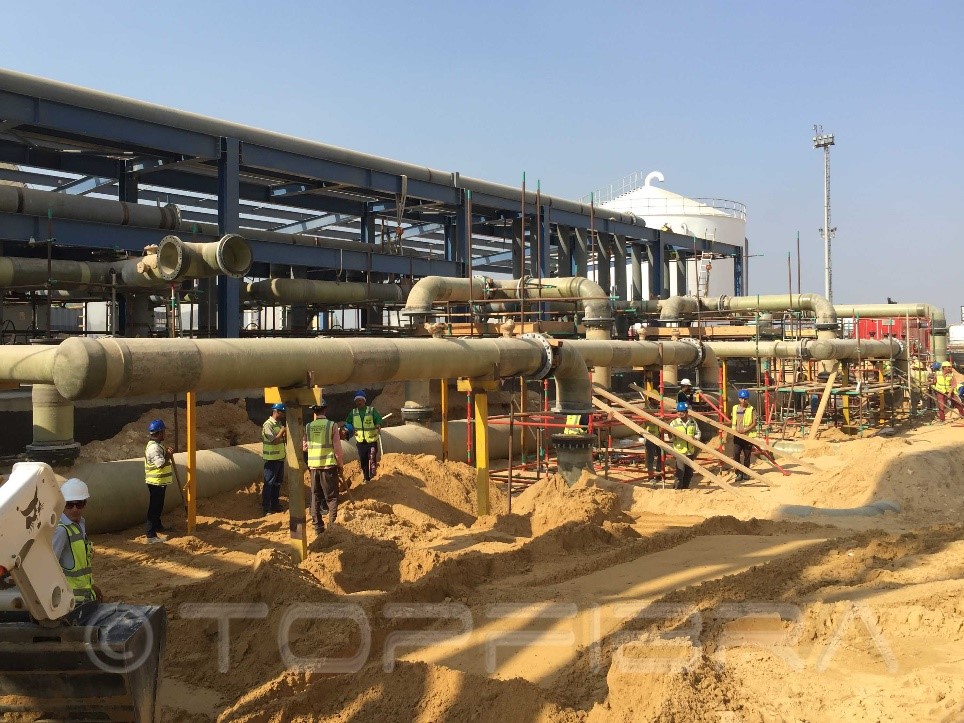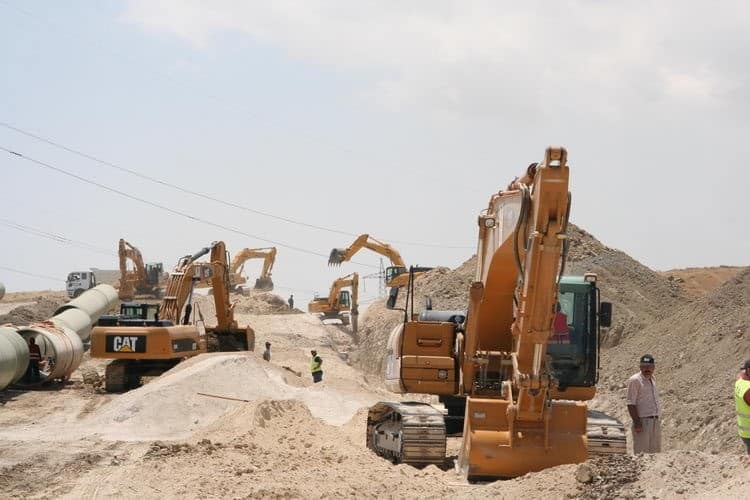GRP pipes are one of the principal pipe materials used in water and sanitary sewerage projects in both gravity and pressure applications.
You probably already know the main advantages of GRP pipes, but let’s just quickly mention some of them:
-
- Compared to cast iron and carbon steel pipes, GRP pipes have elevated corrosion resistance. Nowadays, some producers are even estimating a lifetime of over 100 years. GRP pipes can be designed to resist internal and external corrosion;
- Lightweight construction. Typically, a GRP pipe’s weight is 35% of that of a carbon steel pipe, and 10% of a comparable concrete pipe’s weight. This means the costs of handling, shipping, long-haul transport and site installation are significantly lower;
- Ordinary GRP pipes do not conduct electricity and consequently have much better electrical properties than their steel counterparts. However, if electrical conductivity is required, it is possible to add conductive reinforced fiber or fillers during the fabrication process;
- Due to their composite structure, GRP pipes can be designed to exactly match the project requirements, leading to cost savings;
- Good pressure absorption: they are designed to absorb 40% of the surge pressure, without the need to increase the pressure class;
- Thanks to their smooth inner surface, there is minimum friction loss, and they keep this characteristic throughout their entire service life;
- GRP pipes offer low maintenance costs, stemming from the fact that they do not undergo the corrosive attack that the metallic counterparts have.
They have many advantages, right?
But in order that your GRP pipes perform in the best possible way, you should design and produce them taking into consideration the infrastructure design and the installation conditions into consideration.

After you understand the project requirements, you will need to fine-tune your pipe design and perform the right actions in the correct sequence. Only then, using the correctly equipped production machines, that are specifically designed to increase the performance of your manufacturing plant, will you be able to produce optimal GRP pipes for the project requirements. Finally, you will need to supervise the installation, to get the expected final results, maximizing your profits.
Our EFFECTIVE FILAMENT WINDING® allows you to do exactly that.
The EFFECTIVE FILAMENT WINDING® (EFW®) technology includes all the process and actions that allow you to fine tune your design to perfectly match the project requirements.
Unfortunately, as I wrote in the previous article, many companies initiate projects without being aware of what lies ahead for them. They know how to produce good GRP pipes and they know where they will be installed.
What they do not know is that they will be faced with difficult situations that need to be solved. If they do not find the right solution, the pipeline installation project may go wrong in terms of defects, leaks, delays, consequential damage claims, complaints etc.
Let’s take an example.
Imagine that you produce a GRP pipe within the requirement, you deliver them on time and the installation starts without delays
But suddenly, during the control of the pipe deflection within safe limits (usually 5 % long term to ensure long service life), the inspector finds over-deflection. But you have already installed and buried the pipe. Yes, you are right, a nightmare that could be easily prevented.
Before I continue, please let me clarify the concept of Pipe stiffness.
Pipe stiffness is simply a measure of the pipe’s ability to resist external loads at a given deflection (usually 3-5 %), and is no way related to the pipe’s working pressure. It is therefore possible to produce a 16-bar working pressure pipe with a stiffness of 1.250 N/m2 (of course, also dependent on the diameter), and it is also possible to produce a Gravity pipe with a stiffness of 10.000 N/m2.
The use of higher stiffness pipe should be limited to high external loads applications, such as those that are present in deep buried, gravity sewer lines.
Most pressure pipelines, whether for water lines or in sewer force mains, are installed at relatively shallow to medium depths, that rarely exceed 4 m of cover above the pipes. Over 98 % of pressure pipelines are installed at depths ranging from 1 m to 3 m above the pipe crown.
Yet some agencies have been recently specifying GRP gravity pipes to have a minimum stiffness of 5.000 N/m 2 (for all depths) and pressure pipes to have a minimum stiffness of 10.000 N/m2 trying to solve the problems that have been occurred during the installation.
Unfortunately, almost all these problems are unrelated to pipe stiffness and to specify a high stiffness pipe on new projects will in no way eliminate these problems in the future.
Why?
Because most of these problems were related to errors during the design and/or installation.
Numerous cases of over-deflection (6 % and above) can be attributed to many causes:
-
- Poor compaction of pipe bedding and backfilling material;
- Use of very low stiffness pipe in very deep lines;
- Use of gravel & stones in the bedding and backfill in high ground water table areas.
And of course, the solutions are simple, if you have a method that includes all the phases from the design to the final pipeline test.
As I said before EFFECTIVE FILAMENT WINDING® (EFW®) technology, when installed in your Plant, will manage all the processes and actions, that allow you to fine tune your design to perfectly match the project requirements.
The EFW includes a data-driven, 100% analytical methodology that helps you during the entire process to capture all the required data and take the proper action inside certain parameters.
Once again it should be pointed out, that even if high stiffness pipes are used during an installation with the causes indicated above, the pipes would still suffer significant over-deflection.
Conclusion
I strongly advise you to accurately determine the expected deflection of GRP pipes for a given installation, taking the following into account:
-
- pipe properties (i.e., stiffness);
- native soil properties;
- bedding & backfill material properties;
- trench configuration (width & depth).
In addition to live loads and vacuum conditions expected in the pipeline. Even if the pipeline design is carried out by others.
Remember that most of the problems encountered with older installations of GRP pipes are unrelated to stiffness, and increasing the pipe stiffness today will not prevent these problems from recurring in the future. Thus, do not rely only on the use of high stiffness.
Solution: the EFFECTIVE FILAMENT WINDING® (EFW®) technology, when installed in your Plant, will manage all the process and actions that allow you to fine tune your design to perfectly match the project requirements.


